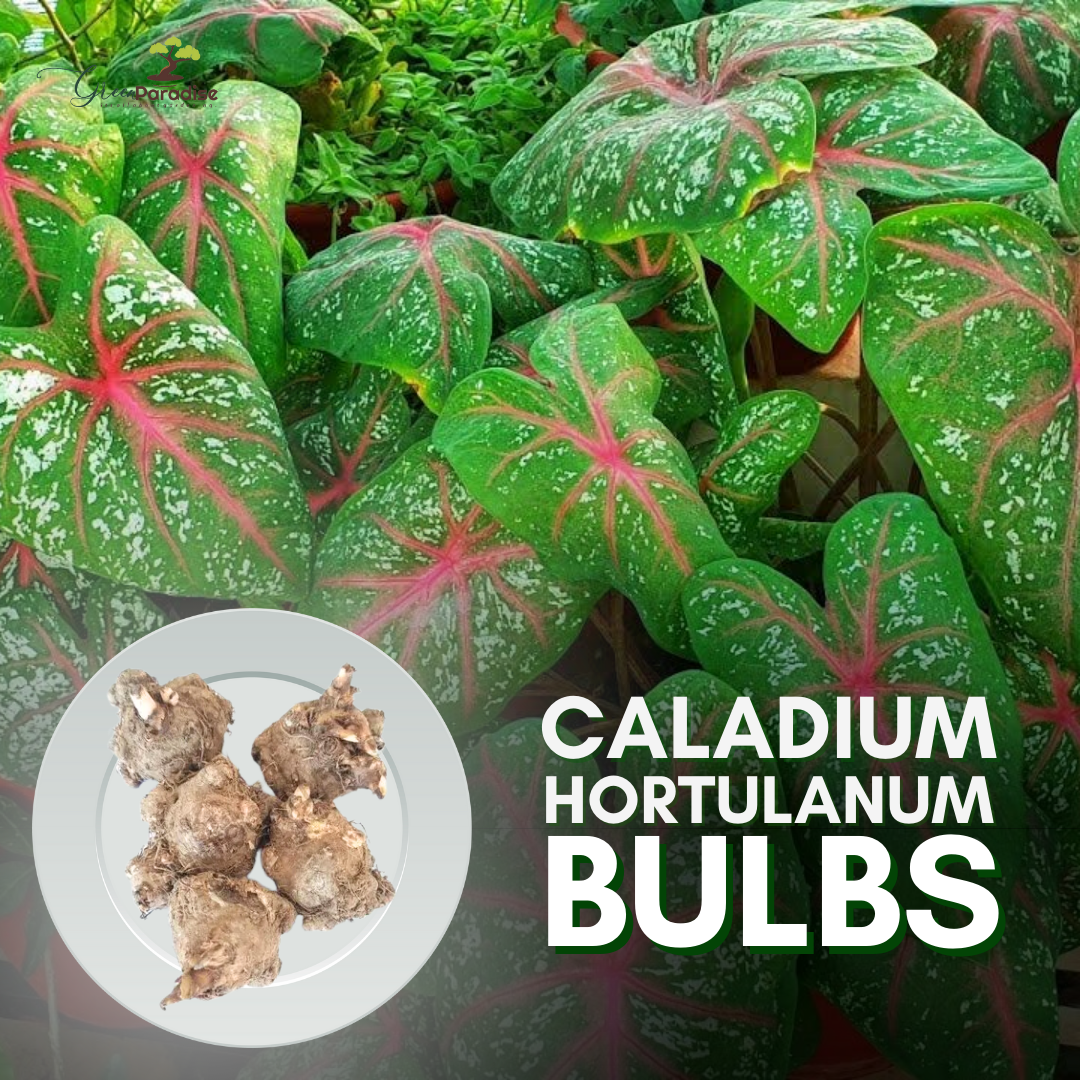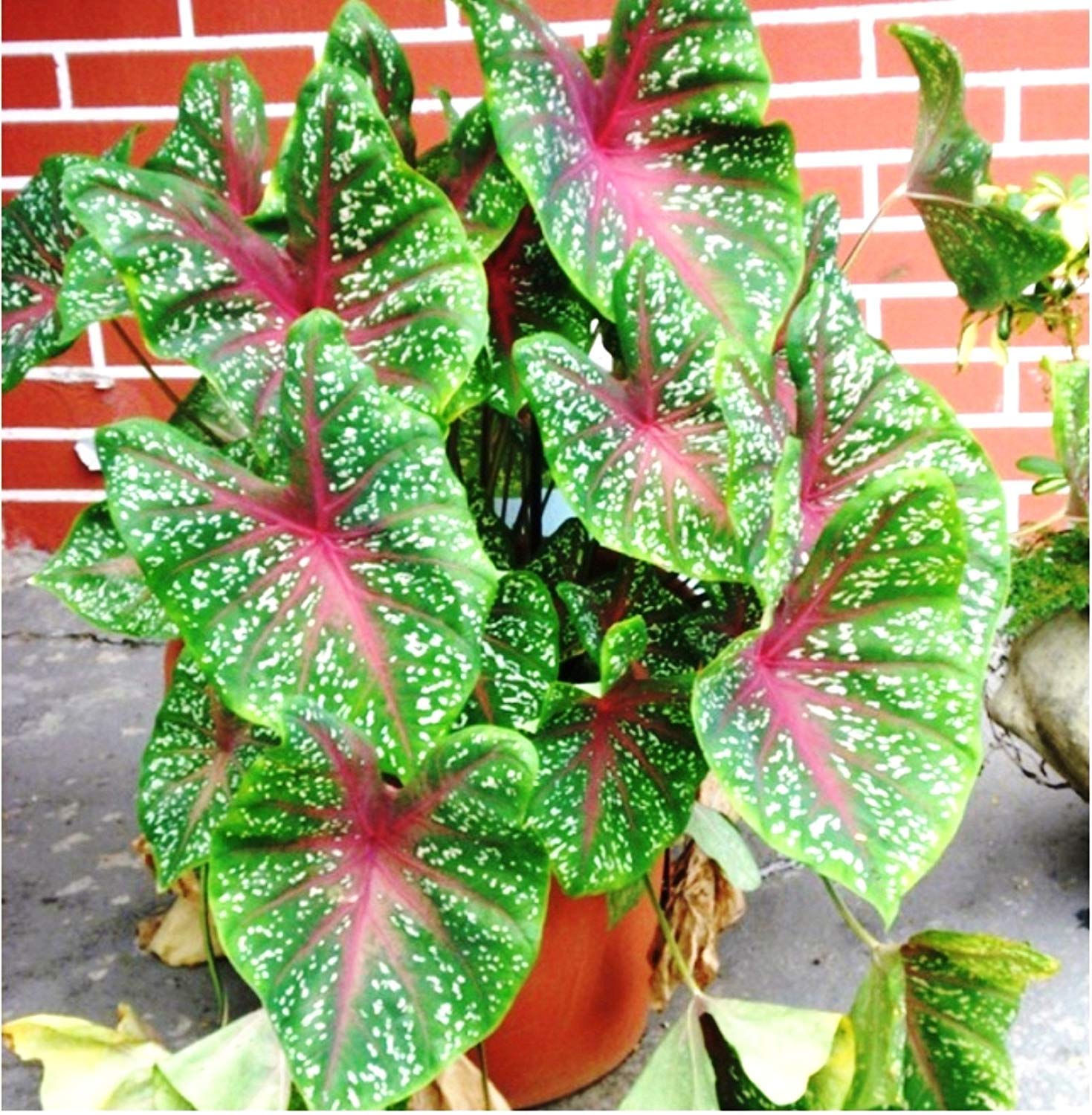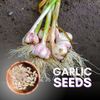

Green Paradise Caladium Hortulanum 5 Fresh Multi colour Bulbs
Rs. 299.00
Guaranteed Safe Checkout
Green Paradise Offers Caladium Hortulanum 5 Fresh Multi Colour Bulbs
About Caladium Hortulanum Plant
Caladium botulinum, commonly known as Caladium or Angel Wings, is a tropical plant prized for its vibrant, colorful foliage. It belongs to the family Araceae and is native to the tropical rainforests of South America, particularly Brazil, and Colombia. Caladiums are popular as ornamental plants due to their strikingly beautiful leaves, which come in a variety of shades and patterns.
Key features of the Caladium hortulanum plant include:
Foliage:
The most distinctive aspect of Caladiums is their large, heart-shaped or arrowhead-shaped leaves. The leaves are typically broad and have prominent veins. The coloration of the foliage varies widely, with combinations of white, green, pink, red, and burgundy hues. Some cultivars also display speckles or variegated patterns.
Growth habit:
Caladiums are herbaceous perennials that grow from tubers. They have an upright growth habit, with the leaves emerging from a central stem. The mature height of the plant can range from 12 to 30 inches (30 to 75 cm), depending on the cultivar and growing conditions.
Light requirements:
Caladiums thrive in bright, indirect light. They prefer filtered sunlight or partial shade, as direct sunlight can scorch their delicate leaves. Inadequate light can result in pale foliage or diminished growth.
Temperature and humidity:
Caladiums are tropical plants and require warm temperatures to thrive. They prefer temperatures between 70°F and 85°F (21°C and 29°C). High humidity is essential for their well-being, and they tend to suffer in dry environments
Watering:
These plants require consistently moist soil but can be sensitive to overwatering. The soil should be well-draining to prevent waterlogged conditions, which can lead to root rot. Regular watering is necessary, especially during the growing season, but it's important to avoid letting the soil dry out completely.
Soil requirements:
Caladiums prefer a rich, well-draining soil mix. A combination of peat moss, perlite, and compost can create an ideal growing medium. The soil pH should be slightly acidic to neutral, ranging between 5.5 and 7.0.
Dormancy and winter care:
Caladiums are dormant during the winter months. As temperatures cool, the leaves will naturally die back. At this stage, reduce watering and allow the plant to rest. It's common to dig up the tubers, store them in a cool, dry place, and replant them when the growing season resumes.
Toxicity:
Caladiums contain calcium oxalate crystals, which can cause irritation and discomfort if ingested. It's important to keep them out of reach of children and pets.
Varieties and cultivars:
There are numerous Caladium cultivars available, each with its own unique foliage color and pattern. Some popular cultivars include 'White Queen,' 'Red Flash,' 'Pink Beauty,' 'Fannie Munson,' and 'Florida Sweetheart.'
Caladium hortulanum plants are often used to add a splash of color to indoor spaces or shady gardens. With their eye-catching leaves and tropical charm, they are an excellent choice for those seeking vibrant foliage plants.
How To Grow Caladium Hortulanum Plants
Caladium hortulanum, commonly known as Caladium or Angel Wings, is a tropical plant grown for its beautiful, colorful foliage.
Here are some general guidelines on how to grow Caladium hortulanum:
Planting Location:
Caladiums prefer partial shade or filtered sunlight. Direct sun should be avoided because it can scorch the leafage. Choose a location with well-draining soil.
Planting Time:
Caladiums are usually planted in spring when the soil has warmed up and the risk of frost has passed. In warmer climates, they can be planted in late winter.
Bulb Selection:
Caladiums are typically grown from tubers or bulbs. Choose healthy tubers with firm, undamaged surfaces. Larger bulbs tend to produce more foliage.
Soil Preparation:
Prepare the soil by incorporating organic matter such as compost or well-rotted manure. This helps improve drainage and fertility.
Direct sun should be avoided because it can scorch the leafage.
Planting Depth:
Plant the tubers with the rounded side facing up, about 2 inches deep. Space them 12 to 18 inches apart, as they need room to spread.
Watering:
Watering: Keep the soil constantly moist but not saturated.
Caladiums require regular watering, especially during hot, dry periods .Avoid allowing the soil to totally dry up.
Fertilization:
Feed your Caladium plants every 4-6 weeks with a balanced, water-soluble fertilizer. Don't have the soil to completely parch out.
Mulching:
Apply a layer of organic mulch around the plants to help retain moisture and suppress weeds. Keep the mulch a few inches away from the tubers to prevent rotting.
Temperature and Humidity:
Caladiums thrive in warm temperatures between 70-85°F (21-29°C) and high humidity. They are not cold-hardy and should be protected from temperatures below 60°F (15°C).
Pests and Diseases:
Caladiums are generally resistant to pests and diseases, but they can be susceptible to aphids, mealybugs, and spider mites. Monitor your plants regularly and treat any infestations promptly with appropriate insecticides or organic remedies.
Winter Care:
In areas with cold winters, Caladiums are often treated as annuals. Once the foliage starts to yellow and die back in the fall, dig up the tubers, allow them to dry for a few days, and store them in a cool, dry place for the winter. Replant them in the following spring.
By following these guidelines, you should be able to grow beautiful Caladium hortulanum plants with their vibrant and eye-catching foliage. Remember to adjust the instructions based on your specific climate and growing conditions.
𝗥𝗲𝗹𝗮𝘁𝗲𝗱 𝗽𝗿𝗼𝗱𝘂𝗰𝘁𝘀
Flowering Plants
Green Paradise® Pink Lotus Tuber for Pond & Water Gardens – Healthy, Ready to Grow Aquatic Flower Plant Bulb
Green Paradise® Pink Lotus Tuber – Premium Aquatic Flower Plant ✨ Product Description: Bring the beauty of vibrant pink lotus blooms to your water garden or pond with the Green...
Rs. 549.00
Flowering Plants
Rare Heliconia Wagneriana Live Plant Heliconia psittacorum Live Plant
Introducing the Exquisite Heliconia Psittacorum Plant: A Tropical Marvel for Your Home Elevate your indoor and outdoor spaces with the captivating beauty of the Heliconia Psittacorum Plant. Renowned for its...
Rs. 499.00
Flowering Plants
Green Paradise Live-Heliconia Wagneriana Plant with Plastic Pot
Green Paradise Offer Beautiful Heliconia Wagneriana Plant About Heliconia Wagneriana Plant Heliconia wagneriana is a stunning and attractive tropical plant known for its unique and colorful inflorescence. Here's what I can...
Rs. 499.00
Flowering Plants
Heliconia rostrata Live Plant heliconia plant Heliconia psittacorum Live Plant
Introducing the Heliconia psittacorum Plant – Nature's Exotic Masterpiece! About Heliconia Psittacorum Plant: Elevate your garden to new heights with the breathtaking Heliconia psittacorum Plant, a true marvel of nature....
Rs. 499.00
Outdoor Plant
Green Paradise® Water Rose (Pistia) – Live Water Cabbage Aquatic Plant for Ponds, Aquariums & Water Gardens | Natural Oxygenating Floating Plant
Green Paradise® Water Rose (Aquatic Pistia) Plant Welcome to the lush world of Green Paradise® Water Rose (Aquatic Pistia)! Our aquatic plant is more than just a decorative addition to your...
Rs. 399.00
Flowering Plants
Heliconia bird of paradise Live healthy Plant-Green Paradise Live
Green Paradise Offers Beautiful Heliconia Bird Of Paradise Plant About Heliconia Bird Of Paradise Plant It seems like there might be a slight confusion in your question. Heliconia and Bird of...
Rs. 349.00
Seeds
Heliconia Golden Torch plant bulbs positive energy and beautiful flowers giving Plant species. (pack of 3)
Green Paradise offers Heliconia Golden Torch Plant About Heliconia Golden Torch Plant Heliconia Golden Torch is a beautiful and striking tropical plant known for its bright and vibrant inflorescence....
Rs. 399.00
Seeds
Heliconia Plant Bulbs Heliconia bihai x marginata 'Rauliniana' 5 Bulbs-Green Paradise Live
Green Paradise Offers Heliconia bihai x Marginata Rhizomes (Pack of 5 Bulbs) About Heliconia Marginata Heliconia marginata, also known as the Red Bassy or Lobster Claw, is a stunning tropical plant...
Rs. 749.00


![Green Paradise Clitoria Ternatea [Aparajita] Double Petal Butterfly Pea Flower [Pack of 10 Seeds]](http://greenparadiselive.com/cdn/shop/files/Blueaparajitaseeds_100x.png?v=1713442074)



